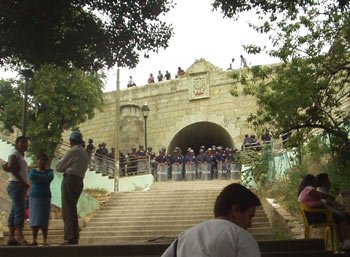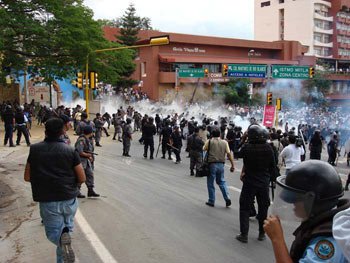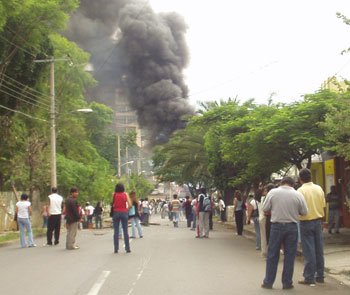


Oaxaca Government Armed Forces Use Violence to Prevent the People's Use of the Guelaguetza Auditorium
Fighting Erupts on Major Streets and on Fortin Hill
By Nancy Davies
Commentary from Oaxaca
July 17, 2007
“Monday on the Hill,” as it is known in Oaxaca, was banned. One could look up the stairs at nine AM and see the rows of riot police armed and waiting. The stairs to the upper plaza were blocked. The Popular Guelaguetza, sponsored by the movement of Teachers and the Popular Assembly of the Peoples of Oaxaca (APPO, in its Spanish initials) were refused use of the public space.
 Photos: D.R. 2006 Nancy Davies |
Another group I did not see stormed up the hill to demand entrance.
The confrontations then began. Niños Heroes Avenue runs an east-west circle, Crespo and Joaquin Amaro go north-south. Standing on Crespo it was possible to see a bus burst into flames on Niños Heroes, to see the clouds of tear gas, to watch the small barricade under construction nearly at my feet, and the riot police stationed one block west at another access to the hill. Youngsters with their faces covered against the teargas were picking up canisters and hurling them, uselessly, back uphill at the police. Others broke up the pavement for stones to throw.
Amid this scene one woman teacher exhorted the fighters to go back to the Plaza de la Danza to regroup. It was not possible from the Crespo vantage point to see where the Guelaguetza delegation had gone. One block east on Joaquin Amaro, the mayhem repeated: tear gas and people running to escape, and others running back toward Niños Heroes. It seemed to me that the streets were filled with people racing in all directions.
According to La Jornada’s electronic edition, at least 40 persons were injured, 20 police were wounded, and some other number were arrested. At least four public transport buses were set on fire, and businesses near Hotel Fortin Plaza were damaged, as was the restaurant of the Hotel. Guests at Hotel Fortin and Victoria Hotel fled the gas.
 |
A Civil Society bulletin reported that at 11:30 AM elements of the Municipal Police, the Preventive Police and the Bank and Industrial Police confronted, with tear gas and stones, the marchers of the APPO and teachers of Section 22 of the National Education Workers Union as they tried to climb to the Guelaguetza Auditorium.
According to that report, the various police units brutally beat teachers and protesters, in addition to launching teargas against commercial establishments, private homes and public buildings. The violent escalation resulted in wounding photographers from Reforma, Noticias, Marca and Tiempo, who were covering the “ferocious blow” by the police against the protesters.
This violence was coordinated by the Secretary for Citizen Protection to impede the celebration of the Popular Guelaguetza, although several days ago the Government of the State declared it would respect the event. “This is a government incapable of dialogue which resorts once again to the irrational use of Public Forces,” the reports states.
By 1:30 the APPO, as far as I could see, had given up the fight, after a struggle of four hours. I saw the tear gas and its effects; I did not see the wounded although we heard the ambulance sirens. I saw men on Niños Heroes throwing projectiles, too far away for me to identify what they threw. I saw the flames and black smoke of the bus.
On Sunday morning the headlines in Las Noticias had forewarned that the Cerro de Fortin, Fortin Hill and the Guelaguetza auditorium on it, would be held by police and military, to prevent its use by the Popular Guelaguetza. The reasons given: 1) The people have no government permission to use the auditorium; 2) the event might make an opportunity for guerrillas of the EPR to blow up this “strategic” site.
 |
Faced with the governor’s proclamation, Section 22 and APPO spokespersons announced that the Popular Guelaguetza would move to Plaza del la Danza, to avoid provocation and a blood bath.
Having just read the movement decision to go elsewhere, on Crespo at 3:00 on Sunday I passed the armed state police (blue uniforms) standing on the side walk with their automatic weapons. Guarding the stairway up the hill the troops wore helmets, shield, and canister belts. Police vans lined the street.
Then, at Carmen Alto Plazuela, the delegations gathered for the official opening of the Popular Guelaguetza. The host identified himself to me as Roberto Matadamas, an official of the Section 22 Cultural Committee. I asked him to identify himself because he explained to the crowd at the plazuela the history of the Guelaguetza, and what it means; then he said, “We are peaceful people and we have struggled without arms for years… Our customs cannot be used for commercial purposes…. this governor has a very small brain… we are going to the Cerro de Fortin over the bodies of the police.”
This game of cat and mouse moved around, because after the show of military at the Fortin stairway starting on Friday, the military subsequently disappeared, then reappeared; Monday morning they stood higher up, where they blocked access to the auditorium and the plaza of the auditorium. But while APPO and Section 22 had decided to move the Popular Guelaguetza to Plaza de la Danza, the more furious members of both organizations had decided to confront the government forces.
 |
Let me back up to discuss the weekend events:
A small table is set up in the Alameda across from the catedrál where people can sign up for the Asamblea Popular de Colonias de Oaxaca (APCO). I stopped to chat for a minute on Friday afternoon of the 13th and was told that up to then, 71 colonias had sent a representative. I asked how may colonias Oaxaca has more than 200, my informant claimed. (The ultimate word I received from the municipal president pre-candidate Victor Raúl Martinez Vasquez: 271 includes colonias and fraccionamientos (private enclaves, often gated). He’s out there campaigning; that’s how he knows.)
By that tally, perhaps one third of the city has enrolled a delegate. Some colonias have only one person, who may hope for a position in a future administration and who represents only himself. Others may be more lively. In either case, 500 persons marched who were not afraid, and a new asamblea was formed.
That first APCO march took place on Friday, July 13. The route crossed from the Monument to Mothers to the zócalo, arriving at the center at six or seven o’clock, depending on who you asked. (I’m getting better at translating times –”natural”; or “government” or “neoliberal”: daylight savings.)
That same day (it’s still Friday) on my way down to see the colonists enter the zócalo, I passed the stairs to Fortin. Buses jammed the street, men lingered on the stairs looking smug in clean white shirts, and along the sidewalk hurried many people whose faces showed the grim look I associate with getting to work on time. Nobody looked to me like they were voluntarily headed to a fun event –no exhilaration, no smiles. Buses hauled in thousands of campesinos from rural areas. Noticias reported traffic jams. One of the men on the stairs told me the event was a PRI rally. Posters showed bigger than life-size ballots, with an appropriate check-mark next to “PRI.”
 |
A fellow-listener told me that people he knows remain fearful after the November repression, and won’t march or attend APPO events. He and several others agreed that the people up at the PRI rally were paid or obliged by their jobs, to come. He himself won’t speak to anyone he doesn’t know. He whispered, “There are many closet APPO.” I laughed, but it isn’t funny.
One thing was clear: those in the zócalo were the pueblo, those at Fortin were the prisoners of Ulises Ruiz. The zócalo restaurants filled up later, and business was good – the PRI have to eat, too.
Saturday
The calenda began in Plazuela Carmen Alto with guys appearing out of nowhere. They ran cables. They carried onto the plaza huge loudspeakers which, with one guy on each handle, were hoisted onto stands. Someone appeared with a microphone. Finally the Juchitán dancers appeared in their costumes, accompanied by the Juchitán band. The announcer explained the popular free Guelaguetza: “Guelaguetza means reciprocal giving. The people give to the government but the people have not received anything in return. So now we give directly to the people.”
After one dance on the plazuela, the calenda assembled with a huge truck leading the way. I counted two dozen security guys wearing visible tags around their necks, who ran in front of and beside the calenda while it danced along for nearly three hours through various colonias. The “cultural events” which followed in the zócalo were attended by several thousands – fireworks, the kind with the bamboo tubes shooting sparks while a person underneath the armature runs around; and the kind shot up into the sky that go Boom. Then the main feature, a dramatic presentation by “Arte en Resistencia” on the kiosko, which was strung with see-through wires. Their title is “Oaxaca is not celebrating, it is mourning” for the dead and disappeared. A Mexican wake. My translation of their flyer:
Dear Tourist: Oaxaca is not celebrating…It is mourning. This is a performance and installation which brings together different disciplines, (musicians, dancers, plastic artists and performers) committed to the social and political moment in Oaxaca.We are not celebrating nor will we, while justice is not given in our state, nor punishment to the assassins of our companions fallen this past year, nor freedom for prisoners who are still in federal and state jails, nor cancellation of orders for arrest nor a halt to the atmosphere of police and military hostilities on the part of the Governor Ulises Ruiz.
Also, it is important to recover what is ours, as is the case with the Guelaguetza, a traditional festival of the people of Oaxaca, presently converted into a private event by the state and losing its original meaning, since the government has sought to emphasize only tourist and commercial needs, at the expense of our people and tradition.
Another major error is that being a celebration of our diversity, the Guelaguetza is now monopolized and centralized, benefiting the same people year after year, that is to say, the politicians and the merchants, since the Oaxaqueños each year are more alienated and they only receive crumbs. It is directed more than anything else to the visitor, which matters only as the economic levy it represents.
It is time to take back what is ours, the most important Oaxaqueña festival of the year, which supposedly gives us identity, unity and a reason to come together culturally, socially and economically. The Guelaguetza can not be reduced to a colorful and attractive tourist business since it already holds for the Oaxaqueños a feeling, a profound sentiment, which should be guarded, in addition to increasing the accords of our present society, to the end of changing it into the most important social cohesion of our pluri-cultural society.
The Guelaguetza should be the common forum for a true interchange, approach, involvement and contact among the peoples, a point of encounter and access to the different customs and values of each place, a cultural, economic, political and social window, to embrace a broad aspect not only of its fiestas and customs but also to take advantage of this forum to discuss matters of common interest, as it can further the use of social currency through our old legacy, the barter, which opens new possibilities for producers, artisans and campesinos; among many other activities which it could implement. That way citizen participation will become important through discussion forums.
Summary:
- In case you wonder why the government might not want a popular guelaguetza, the final paragraph by Arte en Resistencia explains it very well.
- Friday a new asamblea made its debut. Two dozen armed state police remained on Fortin after a PRI rally, along with a few men in military khakis. An APPO member said it was just to intimidate.
- Saturday’s Noticias proclaimed: the government forbids use of the people’s space.
- Saturday and Sunday, traditional events passed with happy participation.
- Monday on the Hill, Lunes Del Cerro, some people once again burst with rage when they were prevented from entering the Guelaguetza area. Thousands of others went to Plaza de la Danza, for the second free year of the Oaxaca Popular Guelaguetza.
- Next week the commercial Guelaguetza is scheduled on the hill. An APPO-teachers boycott was proclaimed but details of it remain unknown.
Click here for more Narco News coverage of Mexico
- The Fund for Authentic Journalism
For more Narco News, click here.




